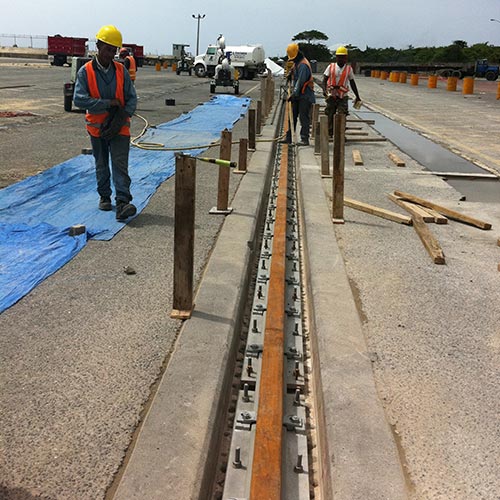
When overhead crane and hoist users look to having world-class safety, operation and condition assessments performed on their cranes and hoists, full runway inspections and assessments are often just an afterthought. This assumption is based upon the presumption that runways are static and will last for years with no maintenance or inspections necessary for many years. In fact, runways are dynamic and require dedicated and specific attention to both inspection and condition assessment to ensure proper safety, trouble-free operation, and the longevity of the crane as well as the runway rails.
The runways, columns, and fasteners are subject to seasonal expansion and contraction stresses caused by fluctuations in temperatures from the cold in winter to the heat in winter. These stresses incur when the runway is supported from the building structure and columns and also when the runway structure is independent and only tied back to the building. The forces of expansion and contraction affect the alignment of runways and columns as well as the stresses on runway tiebacks. Over time tiebacks often break from structural movement and vibrational forces cause from crane operation. Broken tiebacks cause runway alignment problems as well as additional stresses on runway beams that can eventually result in damage to the crane or eventually structural failure.

The routine operation of bridge cranes on the runways causes routine wear to the runway rail from frictional forces. Cranes that are improperly spanned or misaligned will cause accelerated runway rail wear that needs to be quickly addressed to preserve the proper working life of runway rail. Replacement of long runs of runway rail from misaligned runways or cranes can require rail replacement that is often more expensive than the replacement of the bridge cranes themselves. Routine crane operation also causes vibration that loosens fasteners for runways, columns, crane rail, and end stops. These unsecured fasteners often drop from ceiling level elevations, potentially causing head serious injuries to personnel working below.
To properly inspect a runway, proper access must be given to the inspector to visually and physically inspect the entire runway length on both sides as well as the columns and runway girders. In the case where equipment on the floor or inventory impedes access, proper fall protection systems must be installed above the runway beams to allow the inspector to walk the runway safely.

A proper through routine crane runway inspection must be conducted at least annually and should include the following.
1. Inspection of the entire length of runway rail for abnormal or excessive wear to the head and sides
2. Check each component of the rail fastening system for loose hardware.
3. Check the condition and fasteners of runway splices and end stops.
4. Check the condition of end stop bumpers.
5. Check the condition of runway structural beams, columns and shelves or haunches as well as any attachment hardware.
6. Check the condition of all runway tiebacks and their hardware.
7. Any structural bolts that become loose must be replaced and then properly torqued as per AISC guidelines.
8. Where there is severe runway rail wear, a rail alignment, and crane alignment survey should be performed to assess the cause.

As you can probably understand now, a proper runway inspection can not be done in the time normally allotted to a routine crane inspection and must be considered to be a separate item with the proper amount of time allocated that is dependent on access and runway length.
CRANE 1 has fully trained Inspectors and runway assessment experts that are highly qualified to ensure that your runway is safe and maximizes the life and operation of your overhead cranes and runway rail. Call your local CRANE 1 office to learn more about how we can improve your operations.